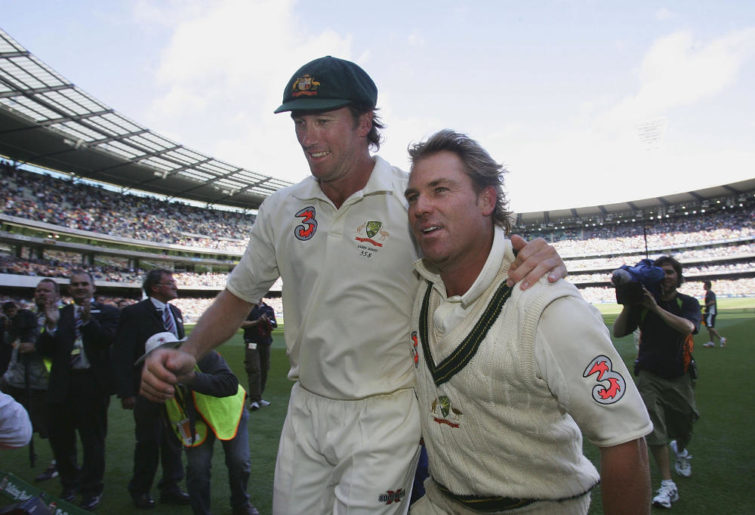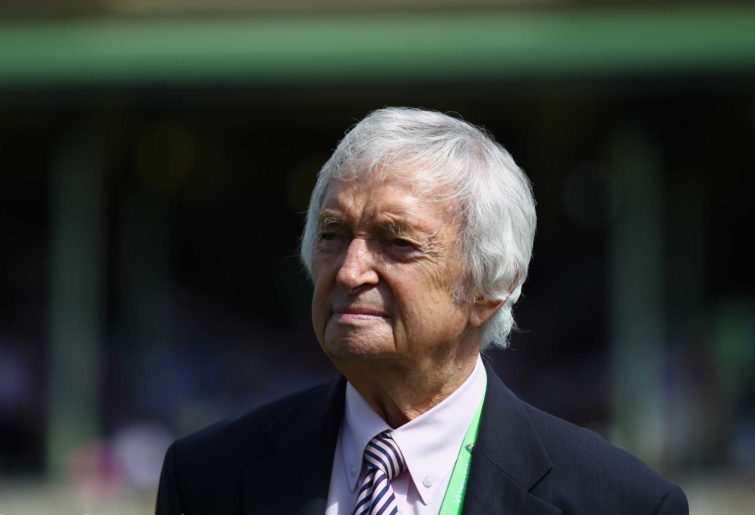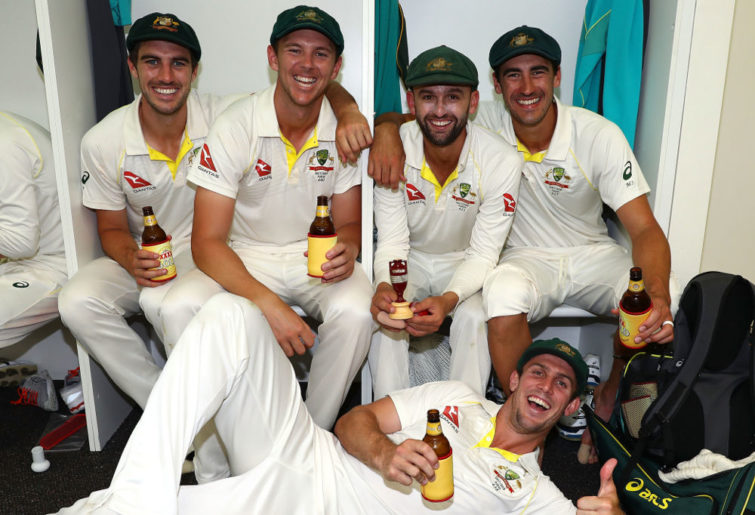“Ashes to ashes, dust to dust, if Lillee don’t get you, Thommo must.”
My recent articles have assessed opening and lower-order batting partners. This one focuses on bowling partners, and specifically on dissimilar ones.
Cricket has been described as a team sport played by individuals. However as in most things, the whole is always greater than the sum of its parts. A great batsman needs teammates to run between wickets with him. And a great bowler needs teammates to take catches and save runs, and to maintain pressure with the ball from the other end of the pitch.
Many players with similar strengths have formed successful partnerships. Their likenesses have not necessarily been a disadvantage. However if each has had limitations in the same areas, then their team has been doubly vulnerable.
Think a pair of David Warners opening the batting in England, or two wrist spinners bowling on a slow-paced green top. One of them might be an asset to his side, but a couple would increase the risk of it being outplayed.
In such circumstances, a team with two players of complementary styles can be more consistently successful. If conditions don’t suit both of them, then they will probably still assist one or the other. And if conditions do suit both, then in combination they will create differing problems for their opponents.
For example an aggressive back-foot batsman and a more restrained front-foot one, or a left-arm swing bowler and a right-arm seamer. Used together, they will improve a team’s overall balance, and increase its captain’s options.
Accordingly this two-piece series will assess chalk-and-cheese pairings, rather than like-for-like ones. Duos like Clarrie Grimmett and Bill O’Reilly, Dennis Lillee and Jeff Thomson, Bill Lawry and Bob Simpson, and Matthew Hayden and Justin Langer will not be considered. And many on-field chalk-and-cheese pairings had dissimilar previous backgrounds as well.

Dennis Lillee (left) and Jeff Thomson. (PA Images via Getty Images)
Part 1 will consider bowling duos because they win matches, with the ball but sometimes also with the bat. Part 2 will look at batsmen, whose role in long-form cricket is to score enough runs quickly enough to leave their teammates sufficient time in which to take 20 wickets.
The five best odd-couple bowling partnerships
Glenn McGrath and Shane Warne
McGrath was the quietly-spoken beanpole from Narromine in northern NSW. He gained the nickname ‘Millard’ by living in one of that company’s caravans after arriving in Sydney, and rarely made an impact with the bat. He is one of the finest fast-medium bowlers of all time, who relentlessly worked batsmen over and out with just enough movement to take the edge of the bat.
Warne was the working-class boy from suburban Melbourne who loved the limelight. He caught well in the slips cordon, and became arguably his country’s greatest ever lower-order batsman. He is the best wrist spinner of all time, with rat cunning and an ability to dismiss well-set batsmen with unplayable deliveries.
They played together 104 times between 1993 and 2007, and in those matches claimed a combined total of 1001 wickets. It is the best ever record by a pair of bowlers. McGrath’s share was 488 at 21.38, while Warne took 513 at 24.87.
When both were on song, Australia was almost unbeatable. They shared 12 or more wickets in a match 25 times; 22 of those games ended in a team victory, with eight by an innings. The sole loss came at the SCG in 1993-94, when South Africa won by five runs despite 12 wickets from Warne and a further two from McGrath. The other two matches were drawn.
At the Oval in 2001, the pair shared 18 wickets in an innings victory. Warne claimed the man of the match award for bowling figures of 7-165 and 4-64, and two catches from McGrath’s bowling. McGrath supported him ably with returns of 2-67 and 5-43. It was the game in which debutant Jimmy Ormond responded to Mark Waugh’s sledging with: “At least I’m the best player in my family.”
When Australia drew four years later at the same ground to conceded the Ashes, the two shared 17 wickets. This time Warne took 6-122, 6-124 and three catches, including two from McGrath whose own contribution was 2-72 and 3-85. Symmetrically, each scored a duck.
Warne also dominated at the Gabba in 1995-96, when the pair shared 16 wickets in an innings win despite Pakistan batting one man short in its first innings. His contribution was 7-23 and 4-54. McGrath added 1-33 and 4-76, leaving only three wickets for the rest of the attack.

(Hamish Blair/Getty Images)
The two excelled at Old Trafford in 1997, with 16 wickets in a 268-run win. McGrath took 3-40 and 4-46, supplemented by one catch and a defiant unbeaten zero with the bat. Warne took 6-48 and 3-63, to go with a second-innings 53. However it was skipper Steve Waugh who claimed the man of the match award, with a century in each innings.
In total, the pair shared ten or more wickets in 43 matches. At times it must have appeared that bowlers of the calibre of Jason Gillespie, Michael Kasprowicz and Brett Lee were merely lower-order batsmen making up the numbers.
Even when fielding, they were each other’s strongest partners. Warne took 30 catches off the bowling of McGrath, with his 11 from Lee a distant second. McGrath claimed nine catches from Warne’s bowling, the most by him from any one teammate.
McGrath claimed the most famous of his catches from Warne’s bowling, against England in Adelaide in 2002-03. After Michael Vaughan had scored 41 runs, he swept uppishly. McGrath was fielding on the square-leg boundary, and ran and dived full length to take the ball one-handed just inches above the ground.
Surprisingly in a joint career that spanned 15 years and 104 matches, the pair batted together only 12 times. The size of their average stand was just 5.58 runs, with a highest partnership of 23. Even McGrath’s promotion twice to number ten to accompany Warne, once ahead of Scott Muller and another before Stuart MacGill, didn’t produce a significant partnership.
Richie Benaud and Alan Davidson
Benaud and Davidson have much in common. Each was an aggressive all-rounder and wonderful fieldsman. They were born a year apart on the outskirts of suburban Sydney, in Penrith and Lisarow respectively. They made their first-class debuts for New South Wales a year apart, their Test debuts similarly, and then each took four years to realise their full potential.
However one was a totally different style of bowler from the other. Benaud bowled leg spin like his father Lou, while Davidson bowled fast left-arm and very occasionally finger spin.
They played 41 matches together between 1953 and 1963, with Benaud as captain in 26 of them, and from those games recorded very similar statistics. It’s impossible to name two all-rounders whose careers were more closely tied.
In those games Benaud scored 1211 runs while Davidson scored 1260. Benaud took 169 wickets while Davidson snared 177. Benaud took 42 catches including 14 off the bowling of Davidson, while Davidson claimed 40 including 12 from Benaud’s bowling.
Benaud and Davidson regularly dominated matches as a bowling duo. They shared 17 wickets once, 15 wickets in another match, 13 wickets in a third match, and 12 wickets on two other occasions.
At Port Elizabeth in 1957-58, the visitors enjoyed a comfortable eight-wicket win. Davidson took 4-44 and 5-38. Captain Benaud supported him with 1-34 and 5-82, as well as scoring 43 and six not out batting in the top five. They shared all ten wickets in the home team’s second innings.
Against England at the Gabba in 1958-59, the home side won by the same margin. Davidson took 3-36 and 2-30 with the new ball, and added 25 valuable runs. His leader took 3-46 and 4-66.
Two months later at the MCG, they again recorded match-turning performances. England started the match at 1-0 after Davidson caught opening batsman Trevor Bailey for a golden duck, and the left armer also returned match figures of 3-38 and 2-95. Benaud scored 64 with the bat, took 4-43 and 1-14 with the ball, and claimed three catches.

(Photo by Ryan Pierse/Getty Images)
In 1959-60, Australia toured India and Pakistan. In Kanpur the team lost despite Benaud and Davidson sharing 17 wickets. The latter took 5-31 and 7-93 with a mixture of pace and spin, and his captain claimed 4-63 and 1-81. Davidson also scored 41 batting at number six.
Australia exacted revenge in Chennai, winning by an innings with Davidson contributing 3-36 and 2-33, and Benaud 5-43 and 3-43. The following game in Kolkata was drawn, with the pair sharing a further 12 wickets.
The duo’s next match-winning performance was in one of Australia’s greatest victories, at Old Trafford in 1961. The team conceded a 177-run first-innings deficit, and in its second innings was only 157 runs ahead with just one wicket in hand.
At that point Davidson counter-attacked with a swashbuckling 77 not out that included 20 runs from one David Allen over, and his 98-run partnership with Graham McKenzie gave the side a defendable 255-run lead. Benaud then spun Australia to victory with 6-70 from 32 overs, to complement Davidson’s hauls of 3-70 and 2-50.
Even when only one of them contributed significantly with the ball, as a duo they still affected match outcomes. The pair shared 18 partnerships which yielded 382 runs, and the highest of them helped create history against the West Indies at the Gabba in 1960-61.
Davidson scored 44 and 80 to go with bowling figures of 5-135 and 6-87, and became the first player to record 100 runs and ten wickets in the same match. On the game’s final day when their side slumped to 6-92 in pursuit of 233 for victory, the pair fought back in a 134-run partnership with Benaud scoring 52. Unfortunately in a frenetic final over the team lost its last four wickets for six runs, and the match was tied.
The duo eventually retired from cricket in successive summers. They then made outstanding off-field contributions to the sport, Benaud in the media and Davidson in administration at state and national level.
Nathan Lyon and Mitchell Starc
Lyon was the late-developing product of Young in southern New South Wales, whose career as a groundsman was interrupted when net bowling at Adelaide Oval. Starc was a lanky young wicketkeeper from northern Sydney, who played his junior cricket against now-wife Alyssa Healy.
To date they have played 59 matches together, commencing in 2011 after debuting three months apart. In those games Starc has claimed 246 wickets at 27.74, while Lyon has taken 226 wickets at 34.11. Starc’s 31 catches have included twice as many from Lyon’s bowling as from any other teammate. Lyon’s taken 26 catches himself, with Starc their most frequent source.
Neither has always been a must-pick selection. Lyon has occasionally been overlooked when selectors have flirted with other slow bowlers including Ashton Agar. Starc has sometimes been collateral damage in horses-for-courses and bowler-rotation strategies.
Their bowling styles have complemented each other particularly well. Fast left armer Starc’s follow-through creates rough areas into which off spinner Lyon can land the ball from the other end. Starc’s reverse-swing ability has until recently also ensured that he and Lyon regularly bowl in tandem with the older ball.

(Photo by Ryan Pierse/Getty Images)
As a pair, they’ve shared 11 or more wickets in a match 18 times. However, eight of those games have ended in defeat.
In Galle in 2016, the visitors suffered a 229-run loss despite Starc’s 5-44 and 6-40, and Lyon’s 2-78 and 2-80. In Colombo a week later the side lost again, even though Starc took 5-63 and 2-72, and Lyon 3-110 and 4-123.
The day-night win over England in Adelaide in 2017-18 saw the pair share 14 wickets. Starc took 3-49 and 5-88, while Lyon claimed 4-60 and 2-45.
When Australia defeated New Zealand in Perth in 2019-20, the duo again shared 15 wickets as Starc starred with 5-52 and 4-45, while Lyon claimed 2-48, 4-63 and a catch from Starc’s bowling. Three weeks later at the SCG, the home side won thanks to Starc’s 1-57 and 3-25, and Lyon’s 5-68 and 5-50 as well as yet another catch from Starc’s bowling.
With the bat, the pair have put together a number of useful partnerships. Against South Africa in Perth in 2012-13, they added 87 runs for the tenth wicket. At Old Trafford in 2019, they shared an undefeated ninth-wicket stand of 59. Against India at the Gabba in 2014-15, their ninth-wicket stand realised 56 runs. And in Mohali in 2020-13, Starc’s 99 enabled a 51-run ninth-wicket partnership with Lyon.
Dennis Lillee and Max Walker
Lillee is arguably the finest fast bowler ever, a West Australian with a classic action and a then-record 355 career wickets. Tasmanian and former VFL footballer ‘Tangles’ Walker was a workmanlike medium pacer with a wrong-footed delivery action.
In 20 matches as teammates between 1973 and 1977, they complemented each other perfectly. During those games Lillee took 103 wickets at 23.66, and Walker 82 wickets at 29.08. Three particular games were notable for an outstanding combined performance.
At the SCG in 1973-74, the pair successfully defended a 159-run target as Pakistan collapsed from 2-48 overnight to 106 all out. Lillee took 3-68 from 23 consecutive eight-ball overs. Walker out-bowled him with figures of 6-15 from 16 overs.
The home team had gained that lead only due to an 83-run ninth-wicket partnership between Bob Massie and debutant John Watkins. Nowadays, such a Pakistani performance would raise more than a few eyebrows.
At Edgbaston in 1975, in the first match of that Ashes series, the pair destroyed the home team with 14 wickets in victory by an innings. Lillee took 5-15 and Walker supported him with 5-48 to dismiss England for 101. When it followed on, each took a further two wickets while Jeff Thomson starred with 5-38.
Their greatest joint effort occurred during the Centenary Test at the MCG in 1976-77, sharing 16 wickets in a 45-run victory. Lillee took a match-winning 6-26 and 5-139. Walker opened the bowling in Jeff Thomson’s absence, and took all remaining first-innings wickets as part of a match return of 4-54 and 1-83. Lillee also scored a crucial ten not out and 25 with the bat, yet was overlooked for the man of the match award in favour of Derek Randall.

Dennis Lillee in action. (PA Images via Getty Images)
At the batting crease they shared 11 partnerships worth a total of 204 runs. The highest yielded 52 runs for the tenth wicket, against Pakistan at the SCG in 1976-77. In that stand Walker scored 34 not out from number 11 as they took the home side from 9-159 to 211 all out.
Bill Johnston and Ray Lindwall
Johnston was a tall, gangly, left-armed medium-pace bowler from the small town of Beeac in western Victoria. He also bowled finger spin when circumstances suited, and batted generally modestly at number 11.
Lindwall was a genuinely great fast bowler from suburban Sydney with a classical action and superb control. He is also the only Australian to have scored two Test centuries batting at number eight or lower, and was an all-round athlete who represented St George as fullback and goal kicker in a New South Wales rugby league grand final.
They played together 37 times between 1947 and 1955, before a knee injury ended Johnston’s career. From those matches, their statistics in the field were remarkably similar. Lindwall took 149 wickets, and Johnston 146. Lindwall took 16 catches including five from the bowling of Johnston, while Johnston took 14 including four from Lindwall’s bowling.
Generally Lindwall opened the bowling with Keith Miller, and Johnston relieved one of them at first change. When the Invincibles retained the Ashes in England in 1948, the pair shared the title of leading bowler with 27 wickets apiece and some outstanding joint achievements.
At Trent Bridge an injury to Lindwall was the catalyst for one of Johnston’s best match returns. In the home side’s first innings the left armer bowled 25 overs to take 5-36, and in Lindwall’s absence in the second he delivered a further 59 overs to take 4-147 and spearhead an eight-wicket win.
As a pair, their greatest bowling performance was at the Oval where they shared 15 wickets. In England’s first innings, Lindwall took 6-20 and Johnston supported him with 2-20 to dismiss it for only 52. In its second innings Lindwall with 3-50 and Johnston with 4-40 ensured victory by an innings. However it was Bradman’s final match and his second-ball dismissal overshadowed all other feats.
Johnston also batted more times with Lindwall, and scored more runs with him in partnership than with any other teammate. While their total aggregate was a modest 160 runs from 11 innings, their 48-run first-innings ninth-wicket stand at Headingley played a part in Australia’s record-breaking chase of 404 for victory in that game.
The best overseas odd-couple bowling partnerships
Sri Lanka’s left-arm medium pacer Chaminda Vaas and off spinner Muttiah Muralitharan were teammates 95 times, taking 309 and 586 wickets respectively in those games.
India’s off spinner Harbhajan Singh and left-arm medium pacer Zaheer Khan took the field together on 59 occasions, in which they took 268 and 206 wickets apiece.
England’s swing bowler Jimmy Anderson and off spinner Graeme Swann played 56 matches together, in which they took 219 and 236 wickets respectively.


































































































